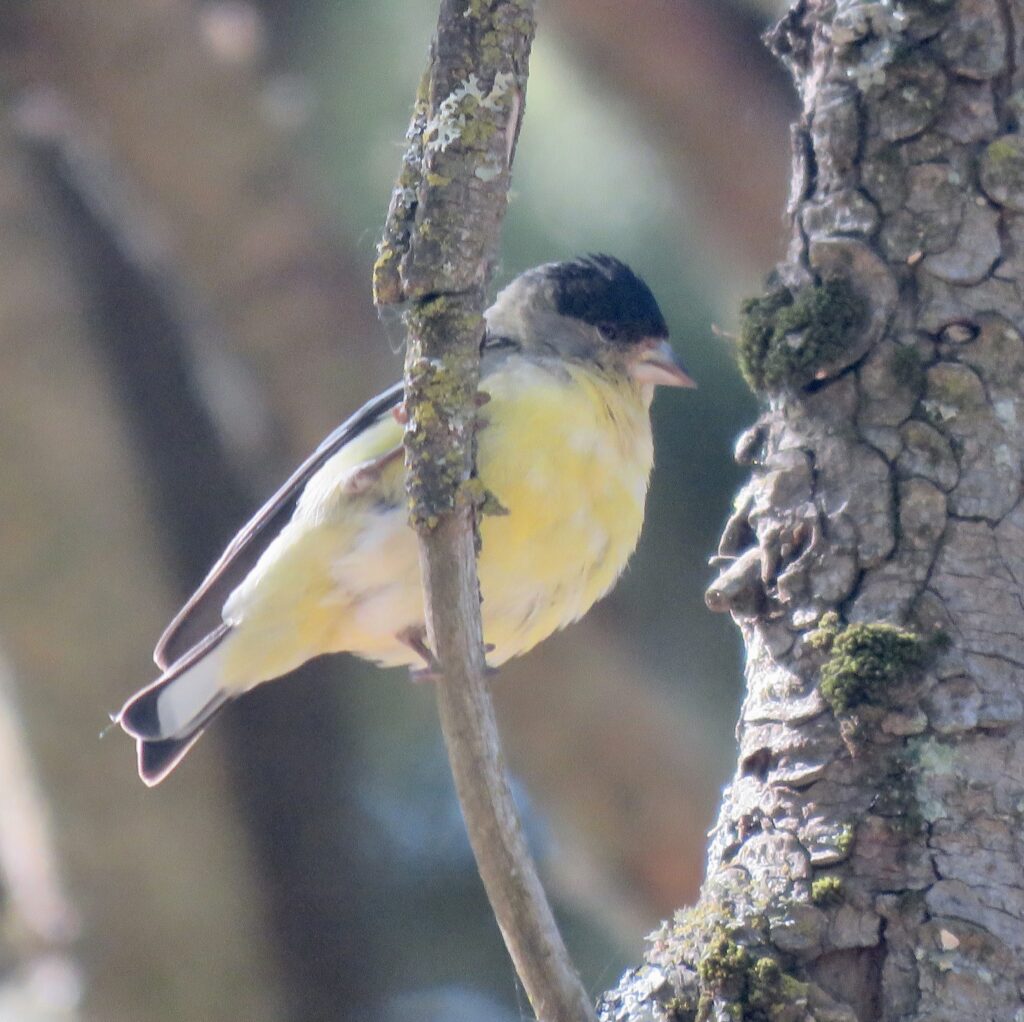Lesser Goldfinch
Spinus psaltria (Say 1853)

Appearance:
Size: L 4.5″
Shape: Small, slender, small-headed bird with a fairly deep-based conical bill. Proportionately shortest tail of our three goldfinches.
Adult Male: Underparts, including undertail coverts, plain yellow; black cap and
dark back (either all dark or greenish or may have dark streaks; back, crown, and ear regions vary in darkness; ears usually not darker than rest); large white patch at base of primaries; 1 white wingbar, white patches in tail on outer 3–4 retrices, not on tip.
Adult Female: Bill dark grayish; bright to dull yellow underparts, including undertail coverts; no black on forehead and crown, olive upperparts; very small white patch at base of primaries; 1 whitish wingbar on greater coverts (a second indistinct bar on median coverts sometimes hidden); little to no white on tail.
1st Winter: Male: like ad. f. but mixed with some black feathers in forehead and crown, contrast between black tertials and brownish wings, and large white patch at base of primaries. Female: like adult f.
Juv: (May–Aug.) Like ad. f. but washed with buff overall, wingbars buffy, white primary patch small or absent.
Natural History
Inhabits a wide variety of habitats of the western United States from Oregon east into Colorado and Texas, and south to Mexico. Seeds, flowers, buds, fruits, and infrequently insects such as plant lice.
Taxonomy
Peter Pyle’s Identification Guide to North American Birds, 2022, lists the green-backed as subspecies S. p. hesperophilus (breeds and winters WA–UT to Baja CA–n.w. Mex), adult m. with back and auriculars olive with dusky streaking or black mottling (rarely almost all black in s.e. UT–s.w. CO to e. AZ–w. NM), f. and imm. with upperparts greener and brighter;
black-backed as S. p. psaltria (breeds and winters CO–OK to s.c. Mex), adult m. back and auriculars all black (or mixed with green in n.w. area of range), f. and imm. upperparts more olive, duller.5 The Cornell Lab of Ornithology Birds of the World account similarly lists them as hesperophilus (n.e. UT–s.e. AZ and west) and psaltria (CO–s.w. NM and east).6
Object of study
One of the least studies finch species. Are the listed subspecies subspecies or perhaps different species. Mimicry in song.
Flight Call
Lower-pitched and more harsh (much less harsh than siskin though) than contact calls of Lawrence’s, and lacking the descending character of American Goldfinch calls; each species gives dis-tinctive, stereotyped, 1- to 5-note calls with little individual variation. Common call is a tee-ee, which is more whistled than the throaty tee-u of Pine Siskin.
Irruptions
Not known to be irruptive, but more investigation might prove otherwise.Its range has been advancing northward and eastward the last few decades though. The Lesser Goldfinch will visit nyjer or sunflower seed feeders of all shapes and forms including nyjer seed socks.



